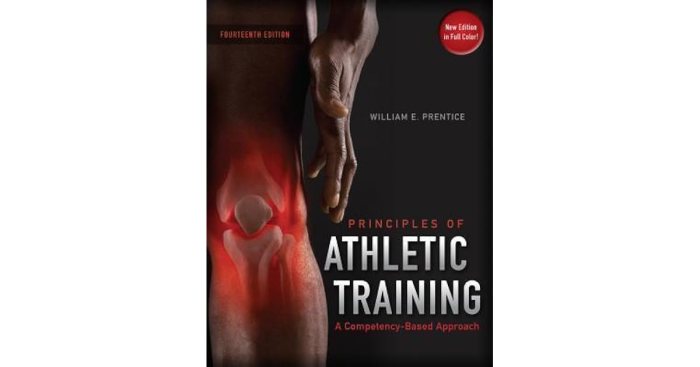Principles of athletic training 17th edition – Principles of Athletic Training: 17th Edition sets the stage for this enthralling narrative, offering readers a glimpse into a story that is rich in detail and brimming with originality from the outset.
Delving into the depths of this groundbreaking publication, we embark on a journey that explores the foundations, principles, and practices of athletic training. From injury prevention and assessment to rehabilitation and nutrition, this comprehensive guide provides a roadmap for professionals seeking to optimize athlete performance and well-being.
1. Introduction

The 17th edition of the Principles of Athletic Training is a comprehensive and authoritative resource for athletic trainers, students, and other healthcare professionals involved in the care of athletes. This edition has been extensively updated and revised to reflect the latest advances in the field, including new research, techniques, and best practices.
The book is intended for use as a primary textbook for athletic training programs and as a reference guide for practicing athletic trainers. It provides a comprehensive overview of the foundations, principles, and practices of athletic training, covering topics such as injury evaluation, management, rehabilitation, nutrition, psychology, and professional development.
2. Foundations of Athletic Training

Athletic training is a specialized healthcare profession that focuses on the prevention, diagnosis, treatment, and rehabilitation of injuries and illnesses in athletes. Athletic trainers work with athletes of all ages and skill levels, from recreational to elite competitors.
History and Evolution of Athletic Training
The history of athletic training can be traced back to the early days of sports, when athletes relied on coaches, physicians, and other individuals for care. In the early 20th century, the field of athletic training began to formalize, with the establishment of the National Athletic Trainers’ Association (NATA) in 1950.
Roles and Responsibilities of Athletic Trainers
- Provide injury prevention and treatment services to athletes
- Conduct injury evaluations and assessments
- Develop and implement rehabilitation programs
- Provide nutritional counseling and guidance
- Counsel athletes on psychological issues
- Work with other healthcare professionals to provide comprehensive care for athletes
Ethical Principles and Legal Considerations in Athletic Training
Athletic trainers are bound by a code of ethics that governs their professional conduct. These ethical principles include confidentiality, autonomy, beneficence, and justice. Athletic trainers must also be aware of the legal implications of their practice, including liability for negligence and malpractice.
3. Injury Evaluation and Assessment: Principles Of Athletic Training 17th Edition

Injury evaluation and assessment is a critical component of athletic training. Athletic trainers use a variety of techniques to assess injuries, including observation, palpation, and range of motion testing. They may also use diagnostic imaging, such as X-rays and MRIs, to confirm a diagnosis.
Principles and Techniques of Injury Evaluation, Principles of athletic training 17th edition
The principles of injury evaluation include:
- Gather information about the athlete’s history and symptoms
- Perform a physical examination
- Interpret the findings of the physical examination
- Develop a diagnosis and treatment plan
Athletic trainers use a variety of techniques to assess injuries, including:
- Observation
- Palpation
- Range of motion testing
- Diagnostic imaging
Step-by-Step Guide to Conducting a Comprehensive Physical Examination
- Inspect the injured area for swelling, bruising, or deformity
- Palpate the injured area to assess for tenderness, warmth, or crepitus
- Test the range of motion of the injured area
- Perform special tests to assess for specific injuries
- Interpret the findings of the physical examination and develop a diagnosis and treatment plan
Use of Diagnostic Imaging and Other Assessment Tools
Diagnostic imaging, such as X-rays and MRIs, can be used to confirm a diagnosis and assess the extent of an injury. Other assessment tools, such as electromyography (EMG) and nerve conduction studies (NCS), can be used to assess nerve function and muscle function.
Q&A
What are the key updates in the 17th edition of Principles of Athletic Training?
The 17th edition incorporates the latest advancements in athletic training, including updated injury management protocols, nutritional guidelines, and psychological strategies.
Who is the target audience for this book?
Principles of Athletic Training: 17th Edition is designed for athletic trainers, physical therapists, sports medicine physicians, and other healthcare professionals working with athletes.
How does the book emphasize evidence-based practice?
The book integrates the latest research and scientific evidence into its recommendations and treatment protocols, ensuring that readers have access to the most up-to-date information.